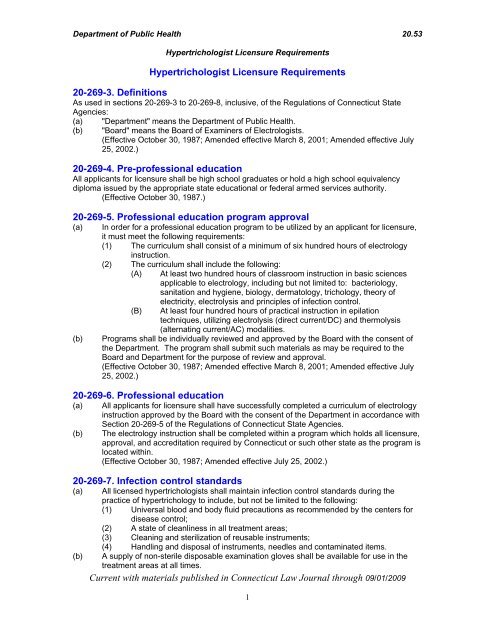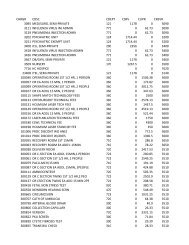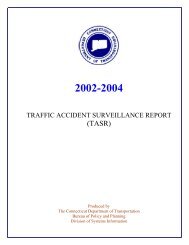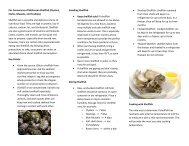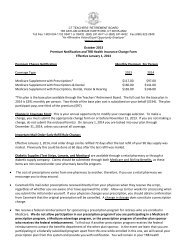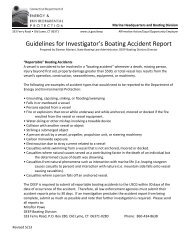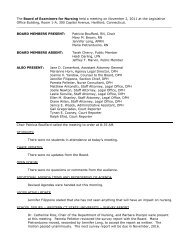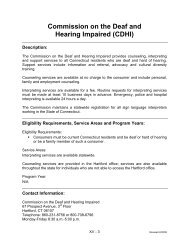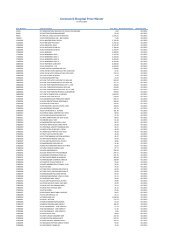Electrologist Licensure Requirements - CT.gov
Electrologist Licensure Requirements - CT.gov
Electrologist Licensure Requirements - CT.gov
Create successful ePaper yourself
Turn your PDF publications into a flip-book with our unique Google optimized e-Paper software.
Department of Public Health 20.53<br />
Hypertrichologist <strong>Licensure</strong> <strong>Requirements</strong><br />
Hypertrichologist <strong>Licensure</strong> <strong>Requirements</strong><br />
20-269-3. Definitions<br />
As used in sections 20-269-3 to 20-269-8, inclusive, of the Regulations of Connecticut State<br />
Agencies:<br />
(a)<br />
(b)<br />
"Department" means the Department of Public Health.<br />
"Board" means the Board of Examiners of <strong>Electrologist</strong>s.<br />
(Effective October 30, 1987; Amended effective March 8, 2001; Amended effective July<br />
25, 2002.)<br />
20-269-4. Pre-professional education<br />
All applicants for licensure shall be high school graduates or hold a high school equivalency<br />
diploma issued by the appropriate state educational or federal armed services authority.<br />
(Effective October 30, 1987.)<br />
20-269-5. Professional education program approval<br />
(a) In order for a professional education program to be utilized by an applicant for licensure,<br />
it must meet the following requirements:<br />
(1) The curriculum shall consist of a minimum of six hundred hours of electrology<br />
instruction.<br />
(2) The curriculum shall include the following:<br />
(A) At least two hundred hours of classroom instruction in basic sciences<br />
applicable to electrology, including but not limited to: bacteriology,<br />
sanitation and hygiene, biology, dermatology, trichology, theory of<br />
electricity, electrolysis and principles of infection control.<br />
(B) At least four hundred hours of practical instruction in epilation<br />
techniques, utilizing electrolysis (direct current/DC) and thermolysis<br />
(alternating current/AC) modalities.<br />
(b) Programs shall be individually reviewed and approved by the Board with the consent of<br />
the Department. The program shall submit such materials as may be required to the<br />
Board and Department for the purpose of review and approval.<br />
(Effective October 30, 1987; Amended effective March 8, 2001; Amended effective July<br />
25, 2002.)<br />
20-269-6. Professional education<br />
(a) All applicants for licensure shall have successfully completed a curriculum of electrology<br />
instruction approved by the Board with the consent of the Department in accordance with<br />
Section 20-269-5 of the Regulations of Connecticut State Agencies.<br />
(b) The electrology instruction shall be completed within a program which holds all licensure,<br />
approval, and accreditation required by Connecticut or such other state as the program is<br />
located within.<br />
(Effective October 30, 1987; Amended effective July 25, 2002.)<br />
20-269-7. Infection control standards<br />
(a) All licensed hypertrichologists shall maintain infection control standards during the<br />
practice of hypertrichology to include, but not be limited to the following:<br />
(1) Universal blood and body fluid precautions as recommended by the centers for<br />
disease control;<br />
(2) A state of cleanliness in all treatment areas;<br />
(3) Cleaning and sterilization of reusable instruments;<br />
(4) Handling and disposal of instruments, needles and contaminated items.<br />
(b) A supply of non-sterile disposable examination gloves shall be available for use in the<br />
treatment areas at all times.<br />
Current with materials published in Connecticut Law Journal through 09/01/2009<br />
1
Department of Public Health 20.53<br />
Hypertrichologist <strong>Licensure</strong> <strong>Requirements</strong><br />
(c)<br />
A sink with hot and cold running water shall be accessible to the treatment area.<br />
(Effective October 30, 1987; Amended effective March 8, 2001.)<br />
20-269-8. Approved electrical methods<br />
The electrical methods approved by the Commissioner of Public Health for the permanent<br />
removal of superfluous hair are those utilizing only needle/probe electrode type epilation which<br />
includes electrolysis (Direct Current/DC), thermolysis (Alternating Current/AC), or the blend (a<br />
combination of both electrolysis and thermolysis).<br />
(Added effective March 8, 2001.)<br />
Current with materials published in Connecticut Law Journal through 09/01/2009<br />
2


